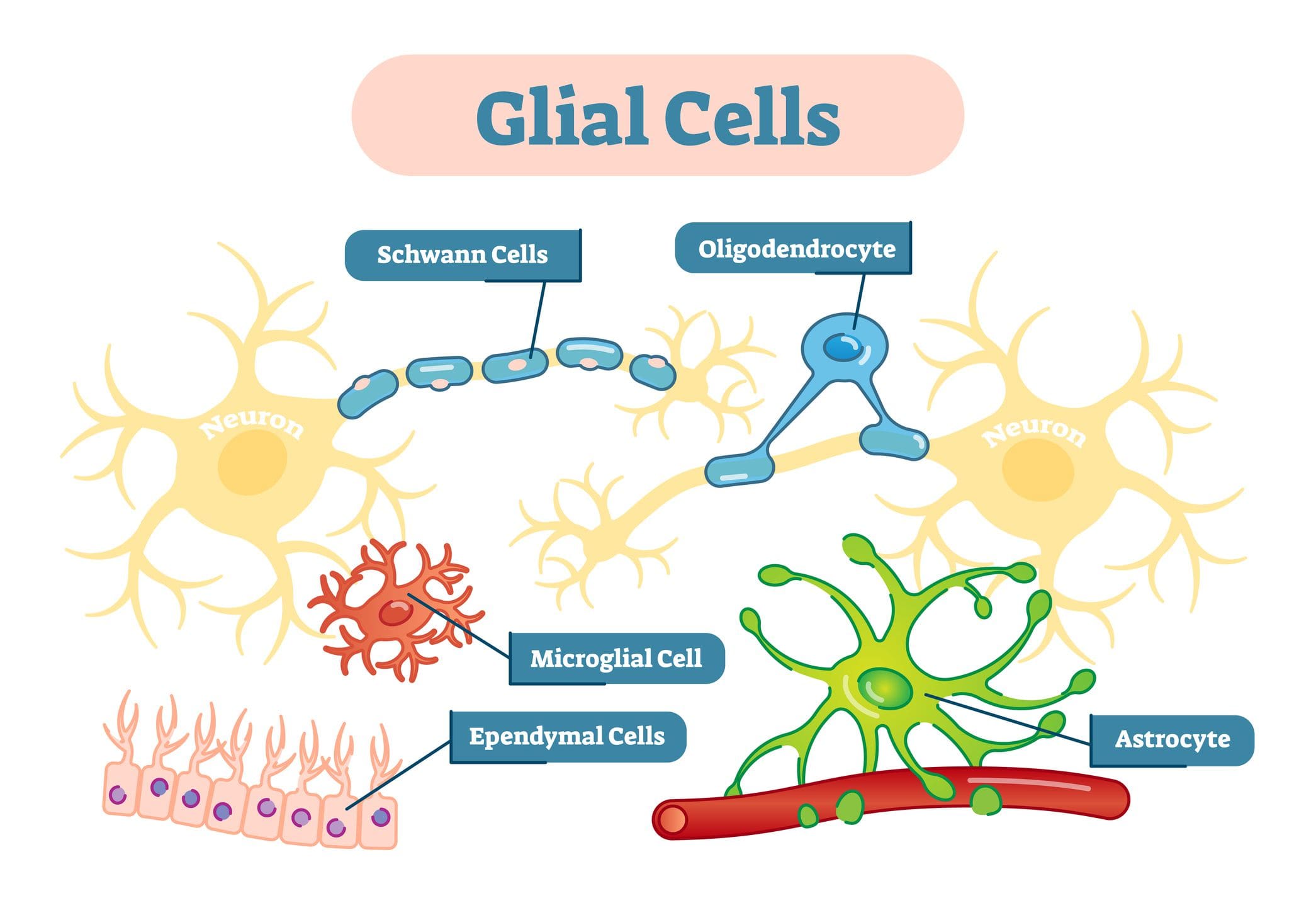You have probably heard about the "gray matter" of the brain which is made up of cells known as neurons, however, a lesser-known type of brain cell is ultimately what makes up the "white matter" of the brain. These are known as glial cells.
Glial cells, also known as glia or neuroglia, were only considered to simply offer structural support. The term "glia" literally translates to "neural adhesive." However, relatively recent research studies have demonstrated that they play a variety of roles in the brain and the nerves which run throughout the entire human body. However, there is more left to find out.
Types of Glial Cells
Glial cells commonly offer support to the neurons. Without them, several of the most fundamental roles would never be achieved although they may not perform these roles themselves. Glial cells come in numerous forms, each of which performs certain functions to keep the brain functioning properly or not, in case of a neurological disease which affects the glial cells.
The central nervous system, or CNS, is made up of the brain, the spinal cord, and the nerves. Five types of glial cells include:
- Astrocytes
- Oligodendrocytes
- Microglia
- Ependymal cells
- Radial glia
Moreover, there are also glial cells on the peripheral nervous system, or PNS, which is made up of the nerves in the upper and lower extremities, away from the spine. The two types of glial cells found in the peripheral nervous system include:
- Schwann cells
- Satellite cells
Astrocytes
The most common type of glial cell in the central nervous system is the astrocyte, also known as astroglia. The "astro" part of the name refers to how they look like stars with projections coming out all over the glial cell. Protoplasmic astrocytes have thick projections with lots of branches. Fibrous astrocytes have long, slender arms. The fibrous ones are found in the white matter while others are found among neurons in the gray matter. Astrocytes play several major roles, including:
- Developing the blood-brain barrier or BBB. The BBB is similar to a strict security system which only allows substances which are supposed to be in the brain. This filtering system is essential for maintaining brain health.
- Regulating the substances around neurons. Neurons communicate utilizing chemical messengers known as neurotransmitters. Once a chemical has transmitted a message to a cell, it essentially stays there cluttering things up until an astrocyte recycles it through a process known as reuptake. The reuptake process is generally the main target of numerous medications, including anti-depressants. Astrocytes also clean up what's left behind when a neuron dies, as well as excess potassium ions, which are chemicals that play a fundamental role in nerve function.
- Regulating blood flow to the brain. For the brain to process information accordingly, it needs a certain amount of blood to flow throughout all of its different regions. An active region receives more blood flow than an inactive one.
- Synchronizing the activity of axons. Axons are characterized as long, thread-like elements of the neurons and the nerve cells which ultimately conduct electricity to help transmit messages from one cell to another.
Astrocyte dysfunction has been potentially connected to a wide variety of neurological diseases, including:
- Amyotrophic lateral sclerosis (ALS or Lou Gehrig's disease)
- Huntington's chorea
- Parkinson's disease
Animal models of astrocyte-related disorders are helping researchers learn more about these neurological diseases.
Oligodendrocytes
Oligodendrocytes develop from stem cells. The term is made up of Greek words which, all together, mean "cells with several branches." Their main role is to help information move faster. Oligodendrocytes appear like white spikey balls. Their purpose is to make a protective layer, similar to the plastic insulation on electric wires. This layer is known as the myelin sheath.
The myelin sheath is not constant. There is a gap between each membrane which is known as the"node of Ranvier," and it is the node which helps electrical signals move effectively along neural cells. The signal is transmitted from one node to the next, which increases the velocity of the nerve conduction whilst also reducing how much energy it takes to transmit it.
Messages along myelinated nerves may travel as fast as 200 miles per second. At birth, you only have a few myelinated axons, and the quantity of these keeps growing until you're about 25 to 30 years old. Myelination is thought to play an important role in intelligence. Oligodendrocytes also supply stability and transmit energy from blood cells into the axons.
The expression "myelin sheath" may be familiar to you because of its association with multiple sclerosis. In multiple sclerosis, it is believed that the human body's immune system attacks the myelin sheaths, which leads to the breakdown of these neurons and ultimately causes impaired brain functioning. Spinal cord injuries may also cause damage to these structures.
Other neurological diseases believed to be associated with oligodendrocyte dysfunction include:
- Leukodystrophies
- Tumors known as oligodendrogliomas
- Schizophrenia
- Bipolar disorder
Several research studies suggest that oligodendrocytes may become affected by the neurotransmitter glutamate, which, among other functions, stimulates regions of the brain so that you're able to focus and learn new information. Nonetheless, in high levels, glutamate can be considered an "excitotoxin," which means that it may overstimulate cells until they die.
Microglia
Microglia are tiny glial cells. They act as the brain's dedicated immune system, which is necessary since the BBB isolates the brain from the rest of the human body. Microglia are attentive to indications of disease and injury. If they find a problem, they are in charge of taking care of it, even if it ultimately means clearing away dead cells or getting rid of a toxin or pathogen.
If they respond to an injury, microglia cause inflammation as part of the recovery process. In some cases, such as in Alzheimer's disease, they might become hyper-activated and cause too much inflammation. That is thought to cause amyloid plaques and other health issues connected with the neurological disease, among a variety of other brain health issues.
Along with Alzheimer's disease, other neurological diseases which may be associated with microglial malfunction include:
- Fibromyalgia
- Chronic neuropathic pain
- Autism spectrum disorders
- Schizophrenia
Microglia have been thought to play many fundamental roles beyond that, including learning-associated plasticity and guiding the development of the brain. The brain produces many connections between neurons which allow them to pass information back and forth. The brain produces a lot more of these than we need, which is not always efficient.
Microglia detect unnecessary synapses and they clean them out. Microglial research has really taken off in recent decades, leading to an ever-increasing comprehension of their roles in both health and disease in the central nervous system.
Ependymal Cells
Ependymal cells are primarily known for creating a membrane known as the ependyma, and it can be described as a thin membrane lining the central canal of the spinal cord and the ventricles or passageways of the brain. They also create cerebrospinal fluid. Ependymal cells are extremely small and they lineup closely together to make the membrane.
Inside the ventricles, are the cilia, which look like small hairs which move back and forth to help circulate the cerebrospinal fluid. Cerebrospinal fluid provides nutrients and removes waste products in the brain. Additionally, it serves as a cushion and shock absorber between the skull and the brain. It's also essential for homeostasis in the brain, regulating its temperature along with other attributes which keep its potential and functioning. Ependymal cells are also included in the BBB.
Radial Glia
Radial glia are believed to be a type of stem cell, which means that they create other types of cells. In the developing brain, they're the"parents" of neurons, astrocytes, and oligodendrocytes. They also supply scaffolding for developing neurons, thanks to long fibers which direct young brain cells into position as the brain forms in a human embryo. Their role as stem cells, especially as founders of neurons, is ultimately what makes them the focus of research studies regarding how to repair brain damage from injury or illness. Later in life, the radial glia perform important roles in neuroplasticity as well.
Schwann Cells
Schwann cells are known after the physiologist Theodor Schwann, who discovered them. They function a lot like oligodendrocytes in which they supply myelin sheaths for axons, but they develop in the peripheral nervous system, or PNS, rather than in the central nervous system or CNS. However, Schwann cells form spirals directly across the axon.
Ranvier's nodes are found between the membranes of oligodendrocytes and these help in neural transmission in precisely the same exact way. Schwann cells can also be part of the PNS's immune system. They ultimately have the ability to consume the axons of the nerve and give a protected path for a brand new axon to develop when another nerve cell is damaged.
Neurological diseases involving abnormal Schwann cells include:
- Guillain-Barre' syndrome
- Charcot-Marie-Tooth disorder
- Schwannomatosis
- Chronic inflammatory demyelinating polyneuropathy
- Leprosy
Several research studies on bronchial Schwann cells for spinal cord injury and other types of peripheral nerve damage have been promising. Schwann cells are implicated in certain types of chronic pain. Their activation following nerve damage may contribute to dysfunction in a type of nerve fiber known as nociceptors, which feel external factors like heat and cold.
Satellite Cells
Satellite cells get their name due to the way they surround certain neurons, with several satellites forming a sheath around the cellular surface. Researchers have only just started to learn about these cells but they're believed to be similar to astrocytes. The main role of satellite cells is believed to be the regulation of the surroundings around the nerves.
The nerves which have satellite cells make up something known as ganglia, which are clusters of nerve cells in the autonomic nervous system and sensory apparatus. The autonomic nervous system regulates internal organs, even while the sensory system is what enables people to see, hear, taste, touch, and smell. Satellite cells provide nourishment to the neuron and absorb heavy metal toxins, such as lead and mercury, to stop them from damaging the nerves and other structures.
They are also believed to assist transport several neurotransmitters and other substances, including:
- Glutamate
- GABA
- Norepinephrine
- Adenosine triphosphate
- Substance P
- Capsaicin
- Acetylcholine
Much like microglia, satellite cells detect and respond to injury and inflammation. However, their role in repairing cell damage isn't yet fully well understood. Satellite cells have been connected to chronic pain between peripheral tissue injury, nerve damage, and a systemic heightening of pain, or hyperalgesia, which can ultimately result from chemotherapy.
Glial cells, also known as glia or neuroglia, are characterized as non-neuronal cells which are ultimately found in the central nervous system, or CNS, and the peripheral nervous system, or PNS. There are various types of glial cells, including astrocytes, oligodendrocytes, microglia, ependymal cells, and radial glia in the CNS and Schwann cells and satellite cells in the PNS. The glial cells play many fundamental roles in the human nervous system. - Dr. Alex Jimenez D.C., C.C.S.T. Insight
The purpose of the article is to discuss the types of glial cells associated with the brain and neurodegenerative diseases. Neurological diseases are associated with the brain, the spine, and the nerves. The scope of our information is limited to chiropractic, musculoskeletal and nervous health issues as well as functional medicine articles, topics, and discussions. To further discuss the subject matter above, please feel free to ask Dr. Alex Jimenez or contact us at 915-850-0900 .
Curated by Dr. Alex Jimenez
Additional Topic Discussion: Chronic Pain
Sudden pain is a natural response of the nervous system which helps to demonstrate possible injury. By way of instance, pain signals travel from an injured region through the nerves and spinal cord to the brain. Pain is generally less severe as the injury heals, however, chronic pain is different than the average type of pain. With chronic pain, the human body will continue sending pain signals to the brain, regardless if the injury has healed. Chronic pain can last for several weeks to even several years. Chronic pain can tremendously affect a patient's mobility and it can reduce flexibility, strength, and endurance.
Formulas for Methylation Support

XYMOGEN’s Exclusive Professional Formulas are available through select licensed health care professionals. The internet sale and discounting of XYMOGEN formulas are strictly prohibited.
Proudly, Dr. Alexander Jimenez makes XYMOGEN formulas available only to patients under our care.
Please call our office in order for us to assign a doctor consultation for immediate access.
If you are a patient of Injury Medical & Chiropractic Clinic, you may inquire about XYMOGEN by calling 915-850-0900.
For your convenience and review of the XYMOGEN products please review the following link.*XYMOGEN-Catalog-Download
* All of the above XYMOGEN policies remain strictly in force.







